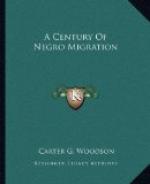In 1820 there occurred so many conflagrations that a vigilance committee was organized.[16] Whether or not the Negroes were guilty of the crime is not known but numbers of them left either on account of the fear of punishment or because of the indignities to which they were subjected. Numerous petitions, therefore, came before the legislature to stop the immigration of Negroes. It was proposed in 1840 to tax all free Negroes to assist them in getting out of the State for colonization.[17] The citizens of Lehigh County asked the authorities in 1830 to expel all Negroes and persons of color found in the State.[18] Another petition prayed that they be deprived of the freedom of movement. Bills embodying these ideas were frequently considered but they were never passed.
Stronger opposition than this, however, was manifested in the form of actual outbreaks on a large scale in Philadelphia. The immediate cause of this first real clash was the abolition agitation in the city in 1834 following the exciting news of other such disturbances a few months prior to this date in several northern cities. A group of boys started the riot by destroying a Negro resort. A mob then proceeded to the Negro district, where white and colored men engaged in a fight with clubs and stones.
The next day the mob ruined the African Presbyterian Church and attacked some Negroes, destroying their property and beating them mercilessly. This riot continued for three days. A committee appointed to inquire into the causes of the riot reported that the aim of the rioters had been to make the Negroes go away because it was believed that their labor was depriving them of work and because the blacks had shielded criminals and had made such noise and disorder in their churches as to make them a nuisance. It seemed that the most intelligent and well-to-do people of Philadelphia keenly felt it that the city had thus been disgraced, but the mob spirit continued.[19]
The very next year was marked by the same sort of disorder. Because a half-witted Negro attempted to murder a white man, a large mob stirred up the city again. There was a repetition of the beating of Negroes and of the destruction of property while the police, as the year before, were so inactive as to give rise to the charge that they were accessories to the riot.[20] In 1838 there occurred another outbreak which developed into an anti-abolition riot, as the public mind had been much exercised by the discussions of abolitionists and by their close social contact with the Negroes. The clash came on the seventeenth of May when Pennsylvania Hall, the center of abolition agitation, was burned. Fighting between the blacks and whites ensued the following night when the Colored Orphan Asylum was attacked and a Negro church burned. Order was finally restored for the good of all concerned, but that a majority of the people sympathized with the rioters was evidenced by the fact that the committee charged with investigating the disturbance reported that the mob was composed of strangers who could not be recognized.[21] It is well to note here that this riot occurred the year the Negroes in Pennsylvania were disfranchised.




